
Niš, less often spelled in English as Nish, is the third largest city in Serbia and the administrative center of the Nišava District. It is located in the southern part of Serbia. According to the 2011 census, the city proper has a population of 182,797, while its administrative area has a population of 260,237 inhabitants.

Baiae was an ancient Roman town situated on the northwest shore of the Gulf of Naples and now in the comune of Bacoli. It was a fashionable resort for centuries in antiquity, particularly towards the end of the Roman Republic, when it was reckoned as superior to Capri, Pompeii, and Herculaneum by wealthy Romans, who built villas here from 100 BC. Ancient authors attest that many emperors built in Baia, almost in competition with their predecessors and they and their courts often stayed there. It was notorious for its hedonistic offerings and the attendant rumours of corruption and scandal.

Stobi or Stoboi, was an ancient town of Paeonia, later conquered by Macedon, and finally turned into the capital of the Roman province of Macedonia Salutaris. It is located near Gradsko, North Macedonia, on the main road that leads from the Danube to the Aegean Sea and is considered by many to be the most famous archaeological site in North Macedonia. Stobi was built where the Erigon joins the Axios (Vardar), making it strategically important as a center for both trade and warfare.
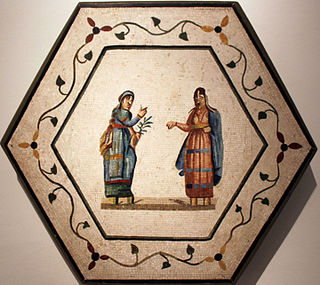
Lorium was an ancient village of ancient Etruria, Italy, on the Via Aurelia, 19 km west of Rome, near today's Castel di Guido.

The Villa Romana del Casale is a large and elaborate Roman villa or palace located about 3 km from the town of Piazza Armerina, Sicily. Excavations have revealed Roman mosaics which, according to the Grove Dictionary of Art, are the richest, largest and most varied collection that remains, for which the site was designated as a UNESCO World Heritage Site in 1997. The villa and its artwork date to the early 4th century AD.
Kostinbrod is a town in western Bulgaria. It is the seat of Kostinbrod Municipality. It is located 15 km west of the capital city of Sofia. It is located on two important transport corridors: Lom — Sofia — Thessaloniki and Sofia — Belgrade. The international railway line to Western Europe passes through the municipality, with a train stop at Kostinbrod Station.

Cottanello is a comune (municipality) in the Province of Rieti in the Italian region of Latium, located about 60 kilometres (37 mi) north of Rome and about 15 kilometres (9 mi) west of Rieti.
Casignana is a comune (municipality) in the Province of Reggio Calabria in region of Calabria, Italy and located about 35 km (22 mi) east of Reggio Calabria.

Brading Roman Villa was a Roman courtyard villa which has been excavated and put on public display in Brading on the Isle of Wight.

The Domus Transitoria was Roman emperor Nero's first palace damaged or destroyed by the Great Fire of Rome in 64 AD, and then extended by his Domus Aurea.
Niš, a city in Serbia's Nišava District, is one of the oldest cities in the Balkans and Europe, and has from ancient times been considered a gateway between the East and the West. The Paleo-Balkan Thracians inhabited the area in the Iron Age, and Triballians dwelled here prior to the Celtic invasion in 279 BC which established the Scordisci as masters of the region. Naissus was among the cities taken in the Roman conquest in 75 BC. The Romans built the Via Militaris in the 1st century, with Naissus being one of the key towns. Niš is also notable as the birthplace of Constantine the Great, the first Christian Roman Emperor and the founder of Constantinople, as well as Constantius III. It is home to one of Serbia's oldest Christian churches dating to the 4th century in the suburb of Mediana.

The Baths of Nero or Baths of Alexander were a complex of ancient Roman baths on the Campus Martius in Rome, built by Nero in either 62 or 64 and rebuilt by Alexander Severus in 227 or 229. It stood between the Pantheon and the Stadium of Domitian and were listed among the most notable buildings in the city by Roman authors and became a much-frequented venue. These thermae were the second large public baths built in Rome, after the Baths of Agrippa, and it was probably the first "imperial-type" complex of baths, with a monumental scale and symmetrical, axially-planned design. While in the sixteenth century the foundations of the caldarium were still visible, nothing else of the structure remains above ground except some fragments of walls incorporated into the structure of Palazzo Madama.

The Villa of Domitian, known as Albanum Domitiani or Albanum Caesari in Latin, was a vast and sumptuous Roman villa or palace built by emperor Domitian. It was situated 20 km (12 mi) from Rome, high in the Alban Hills where summer temperatures are more comfortable. It faced west overlooking the sea and Ostia. To travellers on the via Appia it would have made an impressive sight.
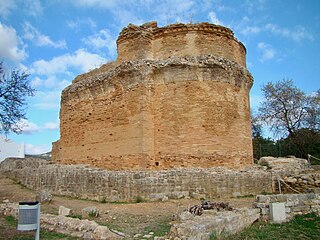
The Roman ruins of Milreu are the remains of an important Roman villa rustica located in the civil parish of Estói in the municipality of Faro, Portugal, classified as a Monumento Nacional. The Milreu ruins constitute the most prominent and well preserved evidence of Roman presence in the Algarve. They are mainly composed of the remnants of a once luxurious villa with annexed thermae and several surrounding buildings, including a temple, mausoleum and industrial and commercial structures. The archaeological site still preserves part of the once exuberant mosaics that decorated the floor and walls of the villa. A 16th century house is also located in the area, alongside an interpretation centre.
The history of the Later Roman Empire covers the history of the Roman Empire from the beginning of the rule of Diocletian in 284 AD and the establishment of the Tetrarchy in 293 AD by Diocletian to the death of Heraclius in 641 AD.
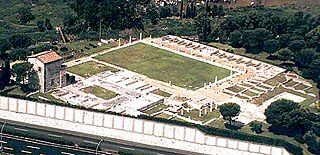
The ancient Roman Villa dei Volusii or Villa dei Volusii-Saturnini is an archaeological site located in the municipality of Fiano Romano, next to the ancient Roman town and sanctuary of Lucus Feroniae, along the route of ancient Via Tiberina.
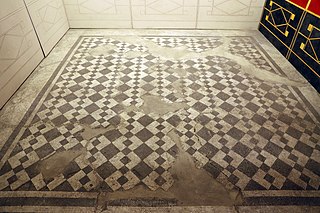
The imperial ancient Roman villa of Ossaia was a large luxurious villa rustica in the rural locality of modern Ossaia, 5 km south of the ancient and modern town of Cortona. It belonged at one time to the family of Augustus, namely his grandsons Gaius Caesar and Lucius Caesar.
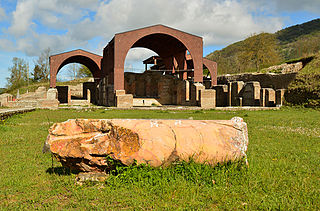
The Villa of Trajan was a palatial summer residence and hunting lodge of the ancient Roman Emperor Trajan, dating from the beginning of his reign. Its location, near the modern village of Arcinazzo, was, like many patrician villas, carefully chosen on high plateau at the foot of Monte Altuino and in a splendid wooded landscape to escape the summer heat of Rome. It is 2 km from the river Aniene which supplied Rome with water and on which Nero's villa at Subiaco is located about 12 km downstream. It occupies an area of about 5 hectares, much of which has yet to be excavated. Many fine room decorations have been recovered here, despite the mass robbing of expensive marbles in previous centuries.
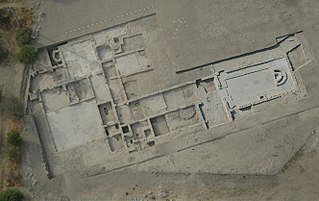
The ancient Roman villa of Faragola was a large, luxurious residence 5 km from ancient Ausculum in today's province of Foggia. Excavations since 2001 have revealed part of the estate with elaborate thermal baths and dining room. It experienced its greatest size between the 4th and 6th centuries, unusually late for Roman villas.

The extensive, luxurious Roman villa Palazzi di Casignana is located on the seashore and near the ancient road linking ancient Locri and Rhegion in today's province of Calabria, Italy. It was discovered in 1964. It reached its zenith during the late empire of the 4th c. AD, a period of turbulence elsewhere.




















